- Table of Content
- 1.Topical Issue ...
- 2.Topical Issue ...
- 3.Guess what?
- 4.Review of sola...
- 5.Review of geom...
- 6.The Internatio...
- 7.Noticeable Sol...
- 8.Geomagnetic Ob...
- 9.The SIDC Space...
- 10.What to attend
2. Topical Issue on "Solar Sources of Space Weather" for JSWSC
3. Guess what?
4. Review of solar activity
5. Review of geomagnetic activity
6. The International Sunspot Index by SILSO
7. Noticeable Solar Events (14 Nov 2022 - 20 Nov 2022)
8. Geomagnetic Observations in Belgium (14 Nov 2022 - 20 Nov 2022)
9. The SIDC Space Weather Briefing
10. What to attend
Topical Issue on "CMEs, ICMEs, and SEPs" for JSWSC
The Journal of Space Weather and Space Climate (JSWSC - https://www.swsc-journal.org/) opens a Topical Issue "CMEs, ICMEs, SEPs: Observational, Modelling, and Forecasting Advances", to appear in 2023.
This Topical Issue stems from the European Space Weather Week 2022, primarily from Session swr02 entitled "Interplanetary Coronal Mass Ejections and Solar Energetic Particles" (https://www.stce.be/esww2022/program/session_details.php?nr=SWR2 ). However, it is not reserved to papers presented during this session, and it is open for all submissions within the scope of this Topical Issue.
Coronal mass ejections (CMEs) and their interplanetary counterparts (ICMEs) are of key interest in the field of solar-terrestrial and solar-planetary relations. They are amongst the largest and most energetic transients in the heliosphere and are the main drivers of the most intense geomagnetic storms. CMEs and ICMEs can also generate shock waves, even very low in the solar corona, producing significant fluxes of solar energetic particles (SEPs), and are important drivers of relativistic electron enhancements in the radiation belts surrounding the Earth. Solar flares associated with CME eruptions can in turn have important impacts (in terms of, e.g., UV radiation and particles) on the Earth’s atmosphere. The rise of Solar Cycle 25 and the ever-growing susceptibility of our society to solar activity are thus reinforcing the need for increasingly realistic data-driven simulations of CMEs/ICMEs and their associated shocks and particle environment using a variety of theoretical, physics-based and semi-empirical models. Additionally, the wealth of in-situ and remote heliospheric observations from novel and long-living missions (such as Parker Solar Probe, Solar Orbiter, STEREO, and SDO), and of enhanced catalogues (such as HELCATS) provide unprecedented complementary datasets for our models, enabling substantial progress in our physical understanding of CME, ICME and SEP events.
This special issue aims at highlighting recent advances in the study of CMEs/ICMEs and SEPs, and in the forecasting of their space weather impact at Earth and other locations in the heliosphere. Contributed papers may present recent developments in the observational, theoretical, and modelling investigation of CMEs/ICMEs and SEPs, including (but not limited to): ICME propagation in the heliosphere, the interaction of ICMEs with terrestrial and planetary environments, the link between CMEs and ICMEs, the generation and transport of SEPs by CME/ICME-driven shocks, and the forecasting of ICME and SEP occurrence, characteristics, and space weather impacts.
Manuscripts must be submitted via the JSWSC online submission tool (https://www.editorialmanager.com/jswsc/ ). Guidelines for submission of papers are found on the JSWSC website under the tab "Instruction for Authors" (https://www.swsc-journal.org/author-information/instructions-for-authors ).
Deadline: 31 July 2023
All manuscripts will be peer reviewed according to the quality standards of international scientific journals. The type of contributions must fit the style of JSWSC. All manuscripts should contain enough new insight, present the results against a properly referenced background of existing work, and present adequate evidence that supports the conclusions.
Accepted papers are published in electronic format only, and are freely available to everyone via the JSWSC website. JSWSC offers the possibility to include electronic material, such as animations, movies, codes and data.
Topical Editor-in-Chief (T-EiC):
Camilla Scolini (camilla.scolini@unh.edu), University of New Hampshire, USA
Topical Editors (TE):
Luciano Rodriguez (luciano.rodriguez@observatory.be), Royal Observatory of Belgium, Belgium
Sergio Dasso (dasso@df.uba.ar), Universidad de Buenos Aires, Argentina
Nicolas Wijsen (nicolas.p.wijsen@nasa.gov), NASA GSFC and University of Maryland College Park, USA
For questions regarding this Topical Issue, please contact the T-EiC. For questions concerning the submission process, the Editorial Office (jswsc@edpsciences.org) should be contacted.
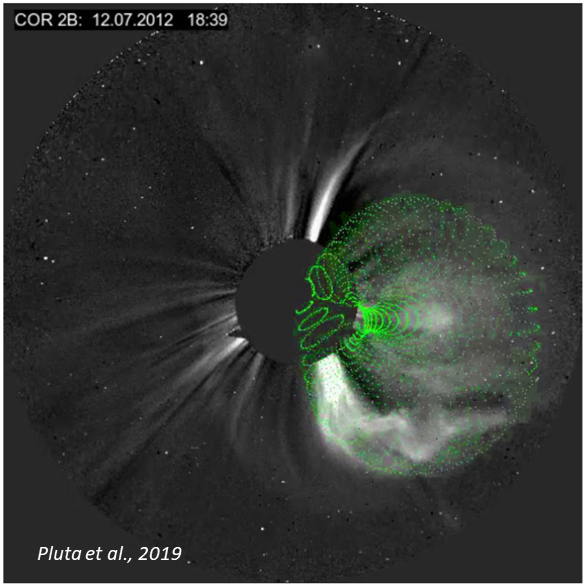
Topical Issue on "Solar Sources of Space Weather" for JSWSC
The Journal of Space Weather and Space Climate (JSWSC - https://www.swsc-journal.org/ ) opens a Topical Issue "Solar Sources of Space Weather".
The Sun and its atmosphere are shaping the heliosphere, including the near-Earth space environment, and driving our space weather. Flares, coronal mass ejections (CMEs), their associated shock waves, and solar energetic particles (SEPs) are the main sources of major space weather disturbances at Earth and the other planets. The strongest events tend to originate from large, magnetically complex active regions, but might also result from CMEs related to large, quiet-Sun filament eruptions. In addition, streamer-blowout stealth CMEs and high-speed streams (HSSs) emanating from coronal holes can unleash moderate storms.
We invite contributions on studies that focus on the build-up, origin, triggering, and early dynamics of solar eruptive events, as well as on space weather effects driven by non-eruptive events, such as HSSs that provide better characterization, diagnostics and deeper physical understanding of the solar sources of space weather at Earth and anywhere in the heliosphere. The scope of this Topical Issue covers both observational and modelling approaches, as well as new techniques and studies on the conditions for moderate to extreme events, which are key to improve space weather predictions.
This Topical Issue arises from Session SWR1 entitled "Solar Sources of Space Weather" at the 18th European Space Weather Week (ESWW2022 - (https://www.stce.be/esww2022/program/session_details.php?nr=SWR1 ) held in October 2022. However, it is not limited to papers presented during this session or the meeting and is open for all submissions within the scope.
Manuscripts must be submitted via the JSWSC online submission tool (https://www.editorialmanager.com/jswsc/ ). Guidelines for submission of papers are found on the JSWSC web site under the tab "Instruction for Authors" (https://www.swsc-journal.org/author-information/instructions-for-authors ).
Deadline: 30 September 2023.
All manuscripts will be peer reviewed according to the quality standards of international scientific journals. The type of contributions must fit the style of JSWSC. All manuscripts should contain enough new insight, present the results against a properly referenced background of existing work, and present adequate evidence that supports the conclusions. Accepted papers are published in electronic format only, and are freely available to everyone via the JSWSC website. JSWSC offers the possibility to include electronic material, such as animations, movies, codes and data.
Topical Editor-in-Chief (T-EiC):
- Judith de Patoul (judith.depatoul@oma.be), Solar–Terrestrial Centre of Excellence, Royal Observatory of Belgium, Brussels, Belgium
Topical Editors (TE):
- Hebe Cremades (hebe.cremades@um.edu.ar), Grupo de Estudios en Heliofísica de Mendoza, CONICET, Universidad de Mendoza, Mendoza, Argentina
- Yana Maneva (yana.maneva@oma.be), Solar–Terrestrial Centre of Excellence, Royal Observatory of Belgium, Brussels, Belgium
- Erika Palmerio (epalmerio@predsci.com), Predictive Science Inc., San Diego, CA, USA
- Li Feng (lfeng@pmo.ac.cn), Purple Mountain Observatory, Chinese Academy of Sciences, Nanjing, China
- Tshimangadzo Merline Matamba (mtshimangadzo@sansa.org.za), South African National Space Agency, Hermanus, South Africa
For questions regarding this Topical Issue, please, contact the T-EiC. For questions concerning the submission process, please, contact the Editorial Office (jswsc@edpsciences.org).

Guess what?
The directors house at the space pole in Ukkel was the scenery for the November 2022 Space Weather Introductory Course. Eight people ran through the series of lectures, exercises, visits ... until they could impersonate a space weather phenomenon or effect.
Do you have an idea of what?
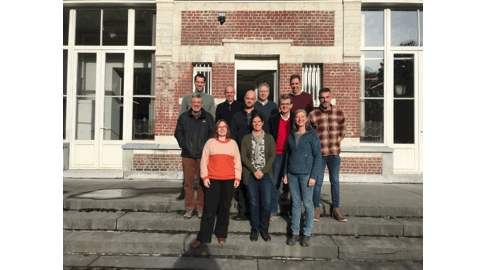
The November SWIC: https://events.spacepole.be/event/139/
More SWICs: https://events.spacepole.be/category/4/
Review of solar activity
Flares
The first part of the week was dominated by three regions in the northwestern quadrant, NOAA active regions 3140, 3141 and 3145. Especially 3140 produced numerous C flares and one M1 flare. These regions rotated over the West limb by the end of the weekend. On November 18, NOAA active region 3150 emerged rapidly in the northwestern quadrant and it produced a number of larger C flares and an M1.6 flare over November 18 and 19. Meanwhile NOAA active regions 3147, 3148 and 3149 had rotated onto the disc in the East but they played only a minor role throughout the week.
Solar Wind disturbances
Several filament eruptions occurred over the course of the week, but none of them was considered to be Earth directed. Before noon 2022-11-13 a filament erupted from the Southern hemisphere. From a location just north of that, another filament erupted later in the week on 2022-11-16 (visible in SoHO/LASCO C2 images from around 13:25UTC). On 2022-11-18 and early 2022-11-19 two CMEs towards the NW and SW are observed in coronagraph images, but these are judged to originate from at or beyond the limb.
Associated to the C8.3 flare from NOAA active region 3150 (2022-11-19 6:23UTC) there is a dimming and a CME towards the west. And this is immediately followed by a filament eruption from the NE quadrant erupting towards the North. Both are too far off Sun-Earth line line to affect Earth. The M1.6 flare (2022-11-19 12:56UTC) had also a dimming and radio bursts associated and a CME towards the NorthWest, again too narrow and off Sun-Earth line.
Solar Energetic Particles
The greater than 10 MeV proton flux was at nominal levels throughout the week. The greater than 2MeV electron flux was below the 1000 pfu threshold. The electron fluence was at normal levels, the full week.
Review of geomagnetic activity
Solar wind remained slightly enhanced but decreasing over the first part of the week with Solar wind speed eventually reaching a minimum of just over 300km/s on November 17. We were then anticipating the arrival of a high speed stream from a large negative polarity coronal hole in the Southern hemisphere on November 19. But this did not set through as prominently as expected.
A period of enhanced interplanetary magnetic field was recorded over late November 18 and November 19 with the magnitude of the interplanetary magnetic field reaching 12nT but solar wind speed did not reach above 400 km/s at that time. Only after having decreased again, did the solar wind speed increase above 400 km/s late on November 20.
With some brief exceptions, the orientation of the field indicated connection with a negative sector (field towards the Sun) throughout the week.
Geomagnetic conditions were quiet to unsettled with locally some active periods during the period of intensified interplanetary magnetic field.
The International Sunspot Index by SILSO
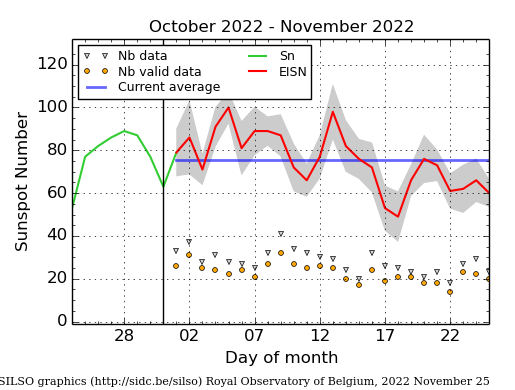
The daily Estimated International Sunspot Number (EISN, red curve with shaded error) derived by a simplified method from real-time data from the worldwide SILSO network. It extends the official Sunspot Number from the full processing of the preceding month (green line), a few days more than one solar rotation. The horizontal blue line shows the current monthly average. The yellow dots gives the number of stations that provided valid data. Valid data are used to calculate the EISN. The triangle gives the number of stations providing data. When a triangle and a yellow dot coincide, it means that all the data is used to calculate the EISN of that day.
Noticeable Solar Events (14 Nov 2022 - 20 Nov 2022)
| DAY | BEGIN | MAX | END | LOC | XRAY | OP | 10CM | TYPE | Cat | NOAA |
| 15 | 0242 | 0251 | 0255 | N23W65 | M1.0 | 1N | 97 | 3140 | ||
| 19 | 1242 | 1256 | 1311 | M1.6 | III/2IV/1II/1 | 3150 |
| LOC: approximate heliographic location | TYPE: radio burst type |
| XRAY: X-ray flare class | Cat: Catania sunspot group number |
| OP: optical flare class | NOAA: NOAA active region number |
| 10CM: peak 10 cm radio flux |
Geomagnetic Observations in Belgium (14 Nov 2022 - 20 Nov 2022)
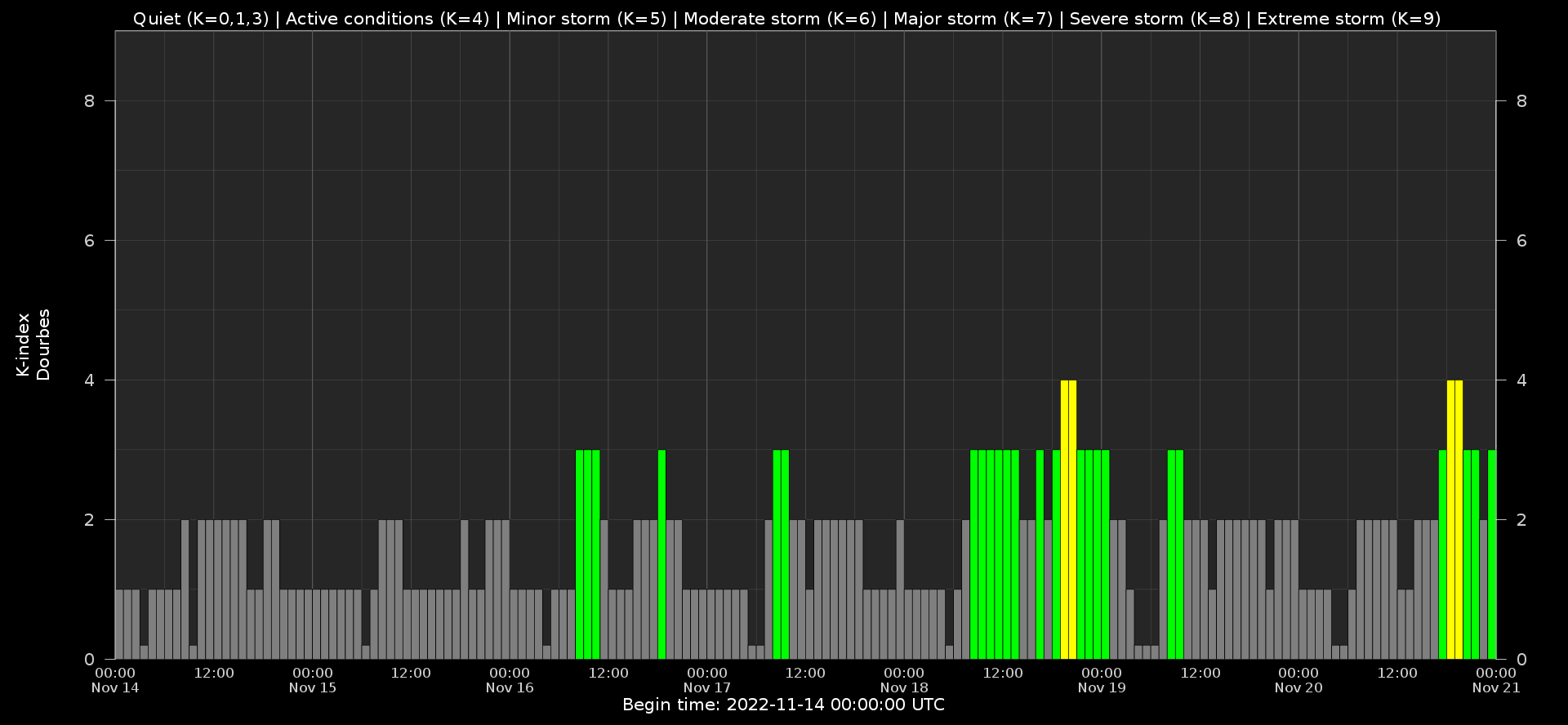
Local K-type magnetic activity index for Belgium based on data from Dourbes (DOU) and Manhay (MAB). Comparing the data from both measurement stations allows to reliably remove outliers from the magnetic data. At the same time the operational service availability is improved: whenever data from one observatory is not available, the single-station index obtained from the other can be used as a fallback system.
Both the two-station index and the single station indices are available here: http://ionosphere.meteo.be/geomagnetism/K_BEL/
The SIDC Space Weather Briefing
The Space Weather Briefing presented by the forecaster on duty from Nov 13 to 22. It reflects in images and graphs what is written in the Solar and Geomagnetic Activity report: https://www.stce.be/briefings/20221121_SWbriefing.pdf
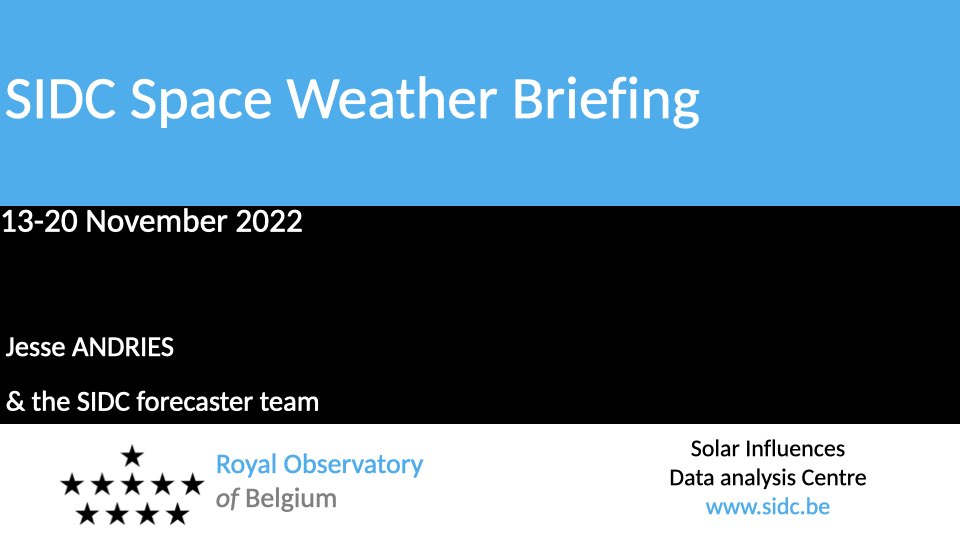
If you need to access the movies, contact us: stce_coordination at stce.be
What to attend
Check out our activity calendar: activities and encounters with the Sun-Space-Earth system and Space Weather as the main theme. We provide occasions to get submerged in our world through educational, informative and instructive activities.
If you want your event in our calendar, contact us: stce_coordination at stce.be
* November 21-23, Space Weather Introductory Course - onsite, by the STCE, Brussels, Belgium - fully booked
* November 27, Dag van de Wetenschap, Planetarium, Belgium
* December 1, Seminar: Total Ozone, UV and radiosonde measurements at Princess Elisabeth Station, Antarctica; onsite and online, RMI
* December 5, 6, 8, 9, Space Weather Introductory Course - online, by the STCE, zoom - fully booked
* December 8, Seminar: Citizen weather reports at RMIB and their use for radar-based hail detection verification, onsite and online, RMI
* January 30, 31, February 2, 3, Space Weather Introductory Course - online, by the STCE, zoom
* March 27-29, Space Weather Introductory Course - onsite, by the STCE, Brussels, Belgium
* May 22-24, Space Weather Introductory Course - onsite, by the STCE, Brussels, Belgium
Check: https://www.stce.be/calendar
